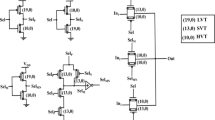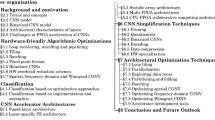Abstract
As developed by Wallace and Dadda, a method for high-speed, parallel multiplication is to generate a matrix of partial products and then reduce the partial products to two numbers whose sum is equal to the final product. The resulting two numbers are then summed using a fast carry-propagate adder. This paper presents Reduced Area multipliers, which employ a modified reduction scheme that results in fewer components and less interconnect overhead than either Wallace or Dadda multipliers. This reduction scheme is especially useful for pipelined multipliers, because it minimizes the number of latches required in the reduction of the partial products. The reduction scheme can be applied to either unsigned (sign-magnitude) or two's complement numbers. Equations are given for determining the number of components and a method is presented for estimating the interconnect overhead for Wallace, Dadda, and Reduced Area multipliers. Area estimates indicate that for non-pipelined multipliers, the reduction in area achieved with Reduced Area multipliers ranges from 3.7 to 6.6 percent relative to Dadda multipliers, and from 3.8 to 8.4 percent relative to Wallace multipliers. For fully pipelined multipliers, the reduction in area ranges from 15.1 to 33.6 percent relative to Dadda multipliers, and from 2.9 to 9.0 percent relative to Wallace multipliers.
Similar content being viewed by others
References
C.S. Wallace, “A Suggestion for a Fast Multiplier,”IEEE Transactions on Electronic Computers, Vol. EC-13, pp. 14–17, 1964.
L. Dadda, “Some Schemes for Parallel Multipliers,”Alta Frequenza, Vol. 34, pp. 349–356, 1965.
L. Dadda, “On Parallel Digital Multipliers,”Alta Frequenza, Vol. 45, pp. 574–580, 1976.
E.L. Braun,Digital Computer Design, New York: Academic Press, 1963.
A. Habibbi and P.A. Wintz, “Fast Multipliers,”IEEE Transactions on Computers, Vol. C-19, pp. 153–157, 1970.
J.C. Majithia and R. Kitai, “An Iterative Array for Multiplication of Signed Binary Numbers,”IEEE Transactions on Computers, Vol. C-20, pp. 214–216, 1971.
A.D. Booth, “A Signed Binary Multiplication Technique,”Q.J. Mechanics and Applied Mathematics, Vol. 4, pp. 236–240, 1951.
P.R. Cappello and K. Steiglitz, “A VLSI Layout for a Pipelined Dadda Multiplier,”ACM Transactions on Computer Systems, pp. 157–174, 1983.
A.E. Gamal et al., “A CMOS 32b Wallace Tree Multiplier-Accumulator,”ISSCC Digest of Technical Papers, pp. 194–195, 1986.
M.R. Santoro, and M.A. Horowitz, “SPIM: A Pipelined 64 × 64-Iterative Multiplier,”IEEE Journal of Solid-State Circuits, Vol. 24, pp. 487–491, 1989.
D.G. Crawly and G.A.J. Amaratunga, “8 × 8 bit pipelined Dadda multiplier in CMOS,”IEE Proceedings, Vol. 135, pp. 231–240, 1988.
K.C. Bickerstaff, M.J. Schulte, and E.E. Swartzlander, Jr., “Reduced Area Multipliers,”Proceedings of the 1993 International Conference on Application Specific Array Processors, pp. 478–489, 1993.
E.E. Swartzlander, Jr., “Merged Arithmetic,”IEEE Transactions on Computers, Vol. C-29, pp. 946–950, 1980.
LSI Logic 1.0 Micron Cell-Based Products Databook, LSI Logic Corporation, Milpitas, California, 1991.
I.H. Unwala and E.E. Swartzlander, Jr., “Super-Pipelined Adder Designs,”1993 International Symposium on Circuits and Systems Proceedings, pp. 1841–1844, 1993.
L. Dadda, “Fast Multipliers for Two's-Complement Numbers in Serial Form,”Proceedings of the 7th Symposium on Computer Arithmetic, pp. 57–63, 1985.
C.R. Baugh and B.A. Wooley, “A Two's Complement Parallel Array Multiplication Algorithm,”IEEE Transactions on Computers, Vol. C-22, pp. 1045–1047, 1973.
Author information
Authors and Affiliations
Rights and permissions
About this article
Cite this article
Bickerstaff, K.C., Schulte, M.J. & Swartzlander, E.E. Parallel reduced area multipliers. Journal of VLSI Signal Processing 9, 181–191 (1995). https://doi.org/10.1007/BF02407084
Received:
Revised:
Published:
Issue Date:
DOI: https://doi.org/10.1007/BF02407084




